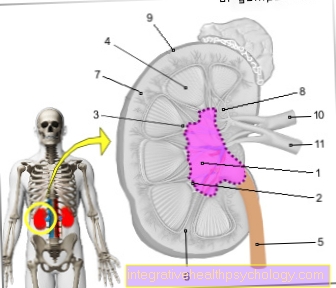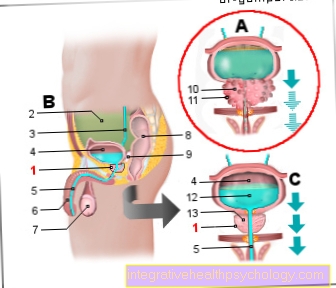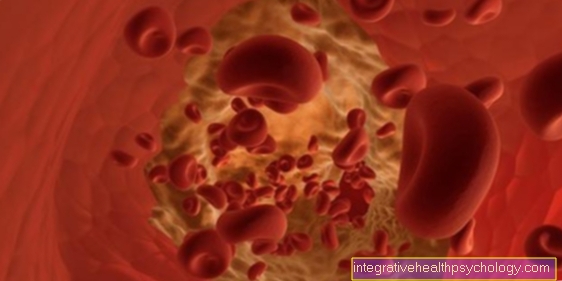Fever and sore throat
What are fever and sore throat?
Fever is an increase in body temperature. The definition of fever is not entirely uniform here. Fever is often mentioned as early as 38 ° C. In the medical field (hospitals, doctor's surgeries), fever is usually only spoken of in adults from a body temperature of 38.5 ° C. Temperatures between 37.1 ° C and 38.4 ° C are then referred to as subfebrile temperatures.
In the medical field, a sore throat usually means pain inside the throat. Muscular pain in the neck region is more likely to be referred to as neck pain.
Sore throats in the narrower sense usually arise as a result of irritation of the mucous membrane of the throat or pharynx.
A sore throat and fever often go hand in hand. Various diseases can be the cause of this.

causes
The most common sore throats and elevated body temperatures are associated with the common and common cold.
However, the body temperature rarely rises above 38.4 ° C, so that in the narrower medical sense we are not talking about fever but only subfebrile temperatures.
In the case of real flu, however, which is triggered by influenza viruses, the body temperature typically rises sharply, to values of up to 41 ° C. Even with influenza, a sore throat often occurs as an accompanying symptom. Other typical symptoms are cough, runny nose, severe pain in the limbs, chills and a significantly reduced general condition.
Inflammation of the lining of the throat (pharyngitis) results in a severe sore throat, but usually there is no fever.
Another typical cause of a combination of fever and sore throat is tonsillar angina, commonly referred to simply as angina or tonsillitis.
An abscess in the throat area can also cause a sore throat and fever. Such an abscess usually develops as a result of an untreated bacterial infection of the ear, nose and throat region.
Another possible cause of fever and sore throat in children and adolescents is Pfeiffer's glandular fever.
In technical jargon one speaks of the so-called infectious mononucleosis. The trigger for this is the Ebstein-Barr virus. There is a sore throat, high fever, swelling of the lymph nodes and significant exhaustion.
Read more on the topic: When should I see a doctor with a fever?
cold
The classic cold, which is very common and overtakes many people several times a year, is accompanied by coughs, runny nose, sore throats and sometimes slight pain in the limbs and a slightly reduced performance.
Fever, i.e. temperatures above 38.4 ° C, occurs extremely rarely with a simple cold.
Subfebrile temperatures between 37 and 38.4 ° C, however, are relatively common.
The common cold usually heals within a few days to about a week without specific therapy.
During the time of the cold, strenuous exercise should be avoided.
Please also read the article: Why is my voice often gone when I have a cold?
Tonsillitis
The tonsillitis is a disease that is classically associated with a combination of fever and severe sore throat. It is a bacterial disease, usually with streptococci. The throat and tonsils are crimson, on the tonsils there are spotty, whitish-yellow coatings, the so-called specks.
Since it is bacterial inflammation, tonsillitis usually requires antibiotics to be treated. In addition, pain relievers and antipyretic agents are used.
In children, tonsillitis can be accompanied by a typical rash (exanthem). One then no longer speaks of tonsillitis but of scarlet fever. Antibiotic treatment is necessary.
Read more about this at: Signs of tonsillitis
allergy
In the case of an allergic reaction, the symptoms of a sore throat and fever are rare.
On the other hand, common symptoms of an allergy are:
- Rash,
- Itching (including around the lining of the mouth and throat),
- watery, very itchy eyes and nose,
- Shortness of breath,
- Palpitations,
- Drop in blood pressure,
- Diarrhea and
- stomach pain
Read more about this under: Sore throat with an allergy
Concomitant symptoms
a headache
Headache is a common symptom that accompanies common colds.
Here they occur together with a cough, runny nose and a slight feeling of exhaustion and a sore throat.
Headache can also be an accompanying symptom of the flu.
Overall, headaches are a very unspecific symptom that can accompany numerous different diseases.
Please also read the article: Fever, dizziness and headache
Body aches
Pain in the limbs is an uncomfortable feeling of heaviness, pain and weakness in the muscles and joints, especially in the arms and legs.
In some cases, back pain can also be classified as a pain in the limbs.
Pain in the limbs is a common symptom of seasonal infections.
In the case of the common cold, they are usually only moderately pronounced, whereas in the case of the flu (influenza) they are often clearly evident.
They are temporary in nature and usually subside after a few days as the infection subsides.
More information on the topic Fever and back pain you'll find here.
Earache
Earache is not a classic symptom of the common cold or flu.
However, especially in children, earache occurs more often as part of an infection and is accompanied by fever and sore throat.
It is important that the ears are also examined when pain occurs in order to be able to rule out otitis media, which is relatively common in children.
Earache can also occur if the ventilation of the inner ear is disturbed by the runny nose that occurs as part of an infection.
Find out more about this in the article: Sore throat with earache
skin rash
If a skin rash occurs in combination with a sore throat and fever, this may be an indication of a scarlet fever infection.
Scarlet fever occurs primarily as a childhood disease. This is an inflammation of the tonsils (angina tonsillaris) in which there is also a red rash that usually begins in the groin area. This rash does not typically appear in the area around the mouth; it is called perioral pallor.
A deep red discoloration of the throat and a raspberry tongue, i.e. a shiny red tongue, are also typical.
Scarlet fever needs antibiotic treatment.
Other childhood illnesses can also be accompanied by a fever and rash, for example three-day fever, rubella, measles, rubella and chickenpox. However, sore throats occur much less often as an accompanying symptom in these diseases than in scarlet fever.
The combination of sore throat, fever and rash is less common in adults.
To be able to recognize a scarlet fever infection, also find out about: The symptoms of scarlet fever
When do I have to see a doctor?
A simple cold, which is accompanied by a mild sore throat and subfebrile temperatures, usually does not require a doctor's visit.
Read more on the topic: When should I see a doctor with a fever?
Even if you have an influenza flu with fever, chills and sore throat, you do not need to see a doctor.
Especially when a high fever occurs, antipyretic drugs should at least be used.
Depending on the drug, these are freely available in the pharmacy (paracetamol) or have to be prescribed by a doctor (Novalgin).
If you have a high fever and a severe sore throat, this can also be an indication of tonsillitis.
This must always be treated with antibiotics. Therefore, the family doctor should be consulted with these symptoms.
The doctor can quickly confirm or rule out tonsillitis and, if necessary, initiate adequate therapy.
Children have a relatively common fever. However, if a high fever occurs combined with a sore throat, a visit to a doctor is also recommended here in order to be able to make a more precise diagnosis. Because tonsillitis requiring treatment is also relatively common in children.
You might also be interested in this topic: How do I know if my fever is contagious?
diagnosis
The doctor examines the mouth and throat in particular to decide whether there is an inflammation of the throat or even a bacterial colonization, as in tonsillitis.
treatment
Whether and how a sore throat and fever should be treated depends on the underlying disease.
Fever can be treated symptomatically with antipyretic, i.e. fever-lowering, agents.
Typically, drugs such as paracetamol, novalgin or ibuprofen are used.
Find out more about this at: How can you lower a fever?
Sore throats often do not need to be treated. However, treatment is required for certain conditions, such as tonsillitis. Here antibiotics, for example penicillin, are used, which have to be taken regularly over several days.
To relieve sore throats, lozenges such as Dolodobendan ® are symptomatic therapy.
Please also read the articles: A Sore Throat - How To Get Rid Of It Quickly! and medicines for sore throats
Home remedies
There are home remedies for both a fever and a sore throat that can relieve the symptoms. However, there is no one and the same home remedy that helps against both a fever and a sore throat.
Therefore, below are some important home remedies that will help either against a fever or a sore throat.
The classic home remedy for fever are leg compresses.
Towels are soaked in lukewarm water, wrung out and wrapped around the calves.
The damp towels are then wrapped outside with dry ones. The wraps can be left on until they have reached body temperature.
The calf wraps can be renewed as often as you like. Particularly with small children, it is important to ensure that the compress is only used when the fever is high and that the water used is not cold but at least lukewarm.
Calf wraps should only be used when the legs and feet are warm. Otherwise it can lead to excessive cooling. The aim of the calf wrap is to remove some heat from the body, which is overheated from the inside, by cooling it from the outside.
A Kneipp version of the calf wrap recommends that you also soak the wrap with vinegar. It is also possible to soak stockings in vinegar water, one then speaks of vinegar stockings.
Read more about this at: Home remedies for a fever
The most common home remedies to relieve a sore throat are warm drinks.
This can be warmer, but not too hot, tea, but hot milk with honey can also work wonders, especially for children. But be careful: children under one year of age are not allowed to consume honey!
Common teas for relieving sore throats are, for example, mixtures containing thyme, sage or chamomile.
Gargle solutions also relieve sore throats. There are different variants, for example gargle solutions that contain apple cider vinegar, salt, aloe vera or chamomile extract. They can easily be made by yourself.
Quark compresses are another home remedy for a sore throat. Quark is placed on a towel as thick as a finger. This is then wrapped around the neck.
But be careful: The quark should not come out of the refrigerator too fresh as it may then be too cold.
A sufficient amount of drinking of at least 2 liters a day also ensures sufficient moisture for the mucous membranes and thus counteracts sore throats.
Read more about this at: Home remedies for a sore throat
homeopathy
There are numerous homeopathic remedies that can be used when a fever or sore throat occurs.
For the treatment of sore throats, for example, the Schüssler salts No. 3 (Ferrum phosphoricum), No. 6 (Kalium sulfuricum), No. 11 (Silicea) and No. 2 (Calcium phosphoricum) are used.
In addition, balaclava (Aconitum napellus), deadly nightshade (Atropa belladonna), sulfur liver (Hepar sulfuris), bushmaster snake (Lachesis muta), black mercury oxide (Mercuris solubilis) and pokeweed (Phytolacca decandra) are said to have a soothing effect.
Read more about this at: Homeopathy for sore throats and tonsillitis
Monkshood and belladonna can provide relief for both symptoms if you have a fever and a sore throat at the same time.
The Schüssler salt No. 3 (Ferrum phosphoricum) is said to have a soothing effect on both fever and sore throats.
For more information, see: Homeopathy for fever
However, it must not be overlooked that symptomatic homeopathic therapy alone is not sufficient for certain diseases.
Duration
How long the sore throat and fever last depends on the underlying disease.
While a simple cold usually doesn't last longer than a week, the flu can cause symptoms for more than a week.
However, fever and sore throat are more likely to occur in the early stages of the disease and decrease as the disease progresses.
With most illnesses, a significant decrease in fever and sore throat can be expected after 3-5 days at the latest.
Special features in children
In children - compared to adults - it is quite common to have a relatively high fever. Mostly viral infections are the cause. A sore throat and fever then last for a few days and then go away on their own.
Symptomatic measures like leg wraps and gargling work well with children too.
If the fever is high, however, antipyretic medication should also be used.
Paracetamol or ibuprofen in particular are used here. For smaller children, usually in the form of suppositories or juice.
Children who have a sore throat and fever should always consider the presence of tonsillitis (angina tonsillaris). If such an angina is present, antibiotic therapy must be initiated. This can be done in children with a penicillin juice.
If a rash occurs in addition to a fever and sore throat, it is very likely that it is scarlet fever, which is relatively common in children.
It must be treated the same way as tonsillitis.
In general, if you have a high fever, you should always consider visiting the treating pediatrician. This can examine the child and decide whether and which therapy is necessary.
Recommendations from the editorial team
- Causes of fever
- Sore throat - what to do?
- Home remedies for a fever
- Fever, dizziness and headache
- Fever and back pain
- How can you lower a fever?







.jpg)














-und-lincosamine.jpg)






